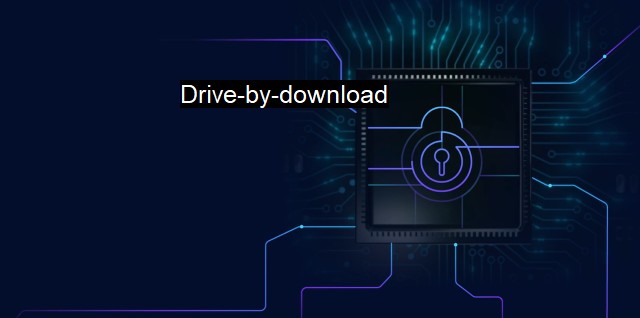What is Drive-by-download?
Stopping Drive-By-Download: Mitigating the Increasing Cybersecurity Threat in Today's Digital Age
Drive-by download is a prevalent term in the digital world, especially within the context of cybersecurity and antivirus software. It refers to the unintentional download of malicious software, or malware, onto a user's system without their conscious approval or knowledge. Unlike other types of malicious software infiltration methods, such as phishing, that usually require some form of volition on the user's side, be it a click on a dubious link or the opening of a suspicious email attachment, drive-by downloads can occur when a user simply visits a website, opens an email, or clicks on a pop-up window.So why is it termed "drive-by download"? The analogy borrows from the term "drive-by shooting," where the shooter makes no direct contact with the victim but simply drives by and fires. Likewise, in drive-by downloading, the victim does not have to carry out any specific action, such as clicking on a certain link or file, to get infected by the malware; merely being in the 'vicinity' of the source of malware, such as being on an infected website, is sufficient.
Drive-by download attacks can be immensely detrimental for a range of reasons. First, they rely heavily on exploiting security gaps, unpatched software vulnerabilities, or bugs in web browsers, and can surreptitiously take control of your device, steal sensitive information or incorporate your device into a botnet. Second, they affect both individual users and large organizations, resulting in serious financial and data losses. the lack of a clear, visible touchpoint makes it hard for users to realize the presence of such malware, rendering traditional defense mechanisms like user awareness and adherence to safe practices ineffective.
In most cases, perpetrators of drive-by download exploits rely on compromised websites to distribute their malware. Cybercriminals often inject malicious scripts into vulnerable or poorly secured websites, which are subsequently relayed to unsuspecting visitors of these sites. The code may installation of malware directly onto the visitor's system or escalate to more hazardous infections, such as the download of additional malicious payloads or redirecting users to other malicious sites.
In terms of types, drive-by downloads can be classified majorly into two categories. First, there are downloads where the malicious software itself is automatically downloaded and installed onto the user's computer without consent or awareness. This typically involves exploiting known vulnerabilities in a browser or a browser plugin. Second, there are downloads where a piece of malicious software disguised as something innocent is acquired by the user, to later wreak havoc on the user's system or data.
To protect systems from drive-by download attacks, cyber vigilance is not enough. Users and organizations must maintain an updated cybersecurity infrastructure. This includes regularly updating all software, predominantly web browsers and their plugins, to close any cybersecurity loopholes that could be exploited. Users must also incredibly careful while surfing the internet and advised not to visit dubious sites, or click on unverified links. Employing reputable antivirus software that can detect such malware and defend against these attacks is also crucial. While antivirus software is not a 100% foolproof way to protect against drive-by download attacks, it does formulate a critical part of an effective defense strategy.
Drive-by downloads represent a major threat in the landscape of cyber-security, capable of inflicting incalculable damage without the user's knowledge. Given their covert nature, they necessitate an ever-vigilant approach towards internet security, consistent updating of software tools, conducive web surfing practices, and the reliance on powerful antivirus software capable of detecting and containing such threats.

Drive-by-download FAQs
What is a drive-by download?
A drive-by download is a type of cyber attack where malware is downloaded onto a user's computer without their knowledge or consent. It typically occurs when a user visits a website that has been compromised with malicious code.How can I protect myself from drive-by downloads?
You can protect yourself from drive-by downloads by keeping your antivirus software up-to-date, avoiding suspicious or untrusted websites, and using a pop-up blocker. It's also important to regularly update your web browser and operating system.What are some signs that my computer may have been infected by a drive-by download?
Some signs that your computer may have been infected by a drive-by download include a slower than usual performance, unexpected pop-ups or alerts, and changes to your computer's settings or homepage. You may also notice that your antivirus software has been disabled or is no longer working properly.What should I do if I think my computer has been infected by a drive-by download?
If you suspect that your computer has been infected by a drive-by download, the first step is to run a full system scan with your antivirus software. You should also disconnect your computer from the internet to prevent the malware from spreading to other devices. If the scan detects malware, follow the instructions provided by your antivirus software to remove it. Finally, be sure to change any passwords that may have been compromised.| | A | | | B | | | C | | | D | | | E | | | F | | | G | | | H | | | I | | | J | | | K | | | L | | | M | |
| | N | | | O | | | P | | | Q | | | R | | | S | | | T | | | U | | | V | | | W | | | X | | | Y | | | Z | |
| | 1 | | | 2 | | | 3 | | | 4 | | | 7 | | | 8 | | |||||||